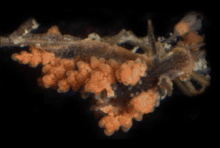Doto chica
Doto chica is a species of sea slug, a dendronotid nudibranch, a marine gastropod mollusc in the family Dotidae.
| Doto chica | |
|---|---|
 | |
| Doto chica on substrate | |
| Scientific classification | |
| Kingdom: | |
| Phylum: | |
| Class: | |
| (unranked): | clade Heterobranchia clade Euthyneura clade Nudipleura clade Nudibranchia clade Dexiarchia clade Cladobranchia clade Dendronotida |
| Superfamily: | |
| Family: | |
| Genus: | |
| Species: | D. chica |
| Binomial name | |
| Doto chica Ev. Marcus & Er. Marcus, 1960 | |
| Synonyms[1] | |
|
Doto fragilis umia Ev. Marcus & Er. Marcus, 1969 | |
Distribution
Distribution of Doto chica includes Florida, Mexico, Costa Rica, Venezuela, Puerto Rico, Curaçao, Cuba, Brazil and Panama.[2]
Description
The body is narrow and elongate.[2] Rhinophores are smooth and rhinophoral sheaths are with small posterior extensions.[2] Cerata are large, with rounded tubercles; apical tubercles much larger than the rest.[2] Background color is translucent gray with a dense series of dark brown spots and a less dense set of opaque white spots on the dorsum.[2] Cerata are with orange extensions of the digestive gland.[2] The maximum recorded body length is 5 mm[2] or up to 10 mm.[3]
Ecology
Minimum recorded depth is 4 m.[3] Maximum recorded depth is 4 m.[3]
It can be found on hydroids.[2] It is known to feed on hydroids of the genus Eudendrium.[2]
References
This article incorporates Creative Commons (CC-BY-4.0) text from the reference[2]
- Rosenberg, G. (2015). Doto chica Ev. Marcus & Er. Marcus, 1960. In: MolluscaBase (2015). Accessed through: World Register of Marine Species at http://www.marinespecies.org/aphia.php?p=taxdetails&id=420621 on 2016-12-15
- Goodheart J. A., Ellingson R. A., Vital X. G., Galvão Filho H. C., McCarthy J. B., Medrano S. M., Bhave V. J., García-Méndez K., Jiménez L. M., López G. & Hoover C. A. (2016). "Identification guide to the heterobranch sea slugs (Mollusca: Gastropoda) from Bocas del Toro, Panama". Marine Biodiversity Records 9(1): 56. doi:10.1186/s41200-016-0048-z
- Welch J. J. (2010). "The “Island Rule” and Deep-Sea Gastropods: Re-Examining the Evidence". PLoS ONE 5(1): e8776. doi:10.1371/journal.pone.0008776.